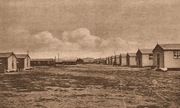
While debate drags on over the future of the prison at Long Kesh there have been calls for an army base in County Down to be transformed into a War of Independence tourism centre.
A senator from north Donegal has called for the former War of Independence internment camp at Ballykinlar in County Down to be turned into an interpretative centre in time for the centenary of the 1916 Rising.
Cecilia Keaveney told the Senate in Dublin she is determined to pursue the plan, which would include similar tourism projects at the Curragh in County Kildare and Frongoch in Wales where may of the 1916 leaders - including Michael Collins - were held.
Opened as an internment camp in 1919, Ballykinlar was also used by the new northern authorities for a period after partition.
It gained a reputation for a particularly brutal regime where prisoners were even shot dead for minor offences.
The Fianna Fail senatoe made the call in an adjournment debate in the Seanad last week.
Junior minister Michael Finneran appeared to reject the Fianna Fail representative’s proposal, reminding her of financial limitations on the government and pointing out that the Ballykinlar base is still owned and operated by the British Ministry of Defence.
But Ms Keaveney said it should be seriously considered as an all-Ireland cultural tourism project.
“I also declare an interest in that my grandfather, James Keaveney, spent 13 months in hut 27 of one of the camps in Ballykinlar,’’ she said.
“As he did not speak to many about his experiences afterwards - as is the case with most prisoners - we hold on to the one story he did leave.
“He had a white handkerchief with a red stain on it. When in later years his son asked him about it, he said that one of the two men who were in two huts separated by a wire fence had received a package from home. “They tried to share information with each other about what was in a letter.
“The guards watching decided that they were planning an escape and so they shot one of the men but the bullet went through him and also killed the other.
“My grandfather said he dipped his handkerchief in the blood so that he would never forget what had happened.”
Ms Keaveney called on arts minister Martin Cullen to start talks with northern authorities about creating interpretative centres at the three internment sites so that all archives could be sourced, collated and displayed.
“This may be controversial. Some people say they cannot decide on what to do with the site of the Maze prison but I do not regard these two issues as being the same. The time factor is significant,” she said.
HISTORY OF REPRESSION
Ballykinlar has played a role in all the major nationalist struggles and events of the last century.
The sprawling site in the shadow of the Mournes was pressed into use as an internment base during the Irish War of Independence in 1919.
Along with the Curragh in Kildare and Frongoch in Wales, it was intended by the British as a place to crush rebellious thoughts among the native Irish.
Ballykinlar had a reputation as a particularly violent place for republican internees. The episode witnessed by Senator Keaveney’s grandfather James involved the shooting of Westmeath men James Sloan and James Tormey in January 1921 for going too close to the perimeter fence.
After partition, the northern authorities continued Ballykinlar’s use as an internment camp, while nationalists were also tortured at Ballykinlar during the most recent conflict.
In more recent years it has been used as a base for the Royal Irish Regiment.
![[Irish Republican News]](https://republican-news.org/graphics/title_gifs/rn.gif)
![[Irish Republican News]](https://republican-news.org/graphics/title_gifs/harp.gif)

